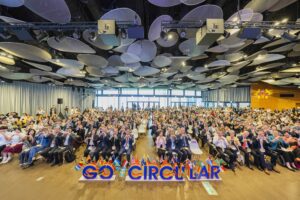
Circular Economy Hub held Circular X “Where We Are in Circular Fashion: Trends in Regulations, Business, and Technology”
- On Aug 31, 2024
- apparel, circular business, Circular Economy, circular fashion, circular society, Circular X, ethical fashion, event, fashion, sustainable fashion, textile
Since 2021, Circular Economy Hub has been holding its monthly Circular X Series, a study program in which participants can learn about the future image of the circular economy spreading in various industries and fields.

The theme for August 2024 was “Where We Are in Circular Fashion: Trends in Regulations, Business, and Technology in the Last Couple of Years.”
It has been pointed out that the apparel and fashion industry’s impact on the natural environment is increasing every year. Issues such as resource consumption to make a single garment, lack of recycling systems for used garments, and the trend toward mass production, mass consumption, and mass disposal continue to persist.
Against this backdrop, there is a growing trend, both in Japan and abroad, to introduce circular business models that aim to reduce new garment production, extend the life of garments, and increase profits, as well as to develop technological innovations, legal systems, and guidelines to support such models.
In the past few years, Europe has developed a Circular Fashion Strategy and Eco-Design Regulations for 2022, and Japan has announced a “Roadmap for Resource Circulation in Textiles,” among other policy developments. On the business side, some progress has been made in the development of recyclable materials using waste materials, a system to prevent overproduction of clothes and sell them at reasonable prices, and moves to expand secondary distribution utilizing both digital and analog technologies. In terms of frameworks, developments toward circular fashion are accelerating, such as the issuance of fashion guidance in the Circular Transition Indicators (CTI) formulated by the World Business Council for Sustainable Development (WBCSD).
Behind this is the fact that business opportunities are lying dormant in these efforts, not to mention the need to reduce environmental impact. According to a 2024 report by the Ellen MacArthur Foundation, circular business models such as rental, resale, repair, and remaking could grow to 23% of the global fashion market by 2030, generating an estimated $700 billion.
The global market for ethical fashion will grow from $8.17 billion in 2023 to $8.83 billion in 2024. It is expected to grow to $12.05 billion by 2028, fueled by growth in emerging markets, increasing foreign direct investment, and growing customer interest in sustainable fashion. (The Business Research Company, “Global Ethical Fashion Market Size 2024, Forecast To 2033“)
In this issue, we learned about the current status of the apparel and fashion industry as it moves toward a circular economy, introducing trends in business models over the past few years, the state of development of laws, regulations, and guidance, and related initiatives, as well as case studies.
[Reference] “Where We Are in Circular Fashion: Trends in Regulations, Business, and Technology in the Last Couple of Years” will be held on 8/29 | Circular Economy Hub (in Japanese)
[Related Site] Circular Economy Hub (in Japanese)


![[Zenbird] Reframing what waste can be through the lens of Kanagawa Sustainability Tour (Report)](https://harch.jp/wp-content/uploads/2025/11/zenbird_tour-report_202511-300x200.jpg)


![[Zenbird] Launch of “Indigo dyeing tour and beginner kendo session exploring Bushido values”](https://harch.jp/wp-content/uploads/2025/11/zenbird_tour_202511_1-300x200.jpg)

